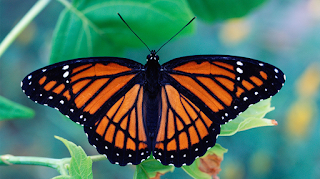How do organisms develop and organised themselves?
Biology is a world of great symmetry. Pleasing to the eye and of spectacular beauty. Some examples include butterflies, others that are less beautiful may include crayfish and ones that are of great curiosity include yourself.
But, biology is also approximate and so there are slight unintended modifications - mistakes.
I must stress, these mistakes (often genetic mutations) are not always bad. Some mutations may cause cancer, some may be of benefit and and some may do nothing at all. But how do you understand organisation when it has small random inaccuracies?
Scientists are studying the incredible developmental coordination and organisation phenomena that our cells, tissues and organs undergo.
Fate Mapping is a method used to study the organisation of cells - typically the embryonic stages of life. 42 years ago an enzyme from the roots of horseradishes was isolated and proved to be an effective marker to study cell progeny. It was able to track the descendants of cells.
Progeny: A descendant or the descendants of a person, animal, or plant; offspring.
Since then Fate Mapping has progressed immensely. Cell Tracing or Cell Lineage Tracing - defined as tracking cell divisions and relocation over time is where markers follow the pattern of cell descendants.
A male worm of the species C. elegans will always have a fixed number of non sex cells (not sperm & egg only all other cells) once they meet maturity (1031 cells). C. elegans is therefore eutelic.
Eutelic: Organisms that have a fixed number of somatic cells (non sex cells) when they reach maturity, the exact number being constant for any one species
A remarkable display of the incredible development and organisation of the organism can be observed.
Embryonic development consists of many stages but below is an image that surmises some key elements that have been demonstrated my fate mapping studies.
Why is it just a worm? and whilst these images look spectacular, can this method assist scientists and clinicians alike?
C. elegans was used to avoid the unfeasible or unethical use of humans for experimentation and has has proven to be a valuable model organism.
Yes.
Through life cells acquire mutations, if these cells happen to be among those that give rise to more cells they will inevitably give their mutation to their decedents.
Reference: https://ui.adsabs.harvard.edu/abs/1978Sci...202.1295W/abstract
 |
| The exceptional symmetry of a butterfly |
I must stress, these mistakes (often genetic mutations) are not always bad. Some mutations may cause cancer, some may be of benefit and and some may do nothing at all. But how do you understand organisation when it has small random inaccuracies?
Scientists are studying the incredible developmental coordination and organisation phenomena that our cells, tissues and organs undergo.
Fate Mapping is a method used to study the organisation of cells - typically the embryonic stages of life. 42 years ago an enzyme from the roots of horseradishes was isolated and proved to be an effective marker to study cell progeny. It was able to track the descendants of cells.
Progeny: A descendant or the descendants of a person, animal, or plant; offspring.
Since then Fate Mapping has progressed immensely. Cell Tracing or Cell Lineage Tracing - defined as tracking cell divisions and relocation over time is where markers follow the pattern of cell descendants.
A male worm of the species C. elegans will always have a fixed number of non sex cells (not sperm & egg only all other cells) once they meet maturity (1031 cells). C. elegans is therefore eutelic.
Eutelic: Organisms that have a fixed number of somatic cells (non sex cells) when they reach maturity, the exact number being constant for any one species
A remarkable display of the incredible development and organisation of the organism can be observed.
Embryonic development consists of many stages but below is an image that surmises some key elements that have been demonstrated my fate mapping studies.
 |
| Embryonic development |
Why is it just a worm? and whilst these images look spectacular, can this method assist scientists and clinicians alike?
C. elegans was used to avoid the unfeasible or unethical use of humans for experimentation and has has proven to be a valuable model organism.
Yes.
Through life cells acquire mutations, if these cells happen to be among those that give rise to more cells they will inevitably give their mutation to their decedents.
Reference: https://ui.adsabs.harvard.edu/abs/1978Sci...202.1295W/abstract
Comments
Post a Comment